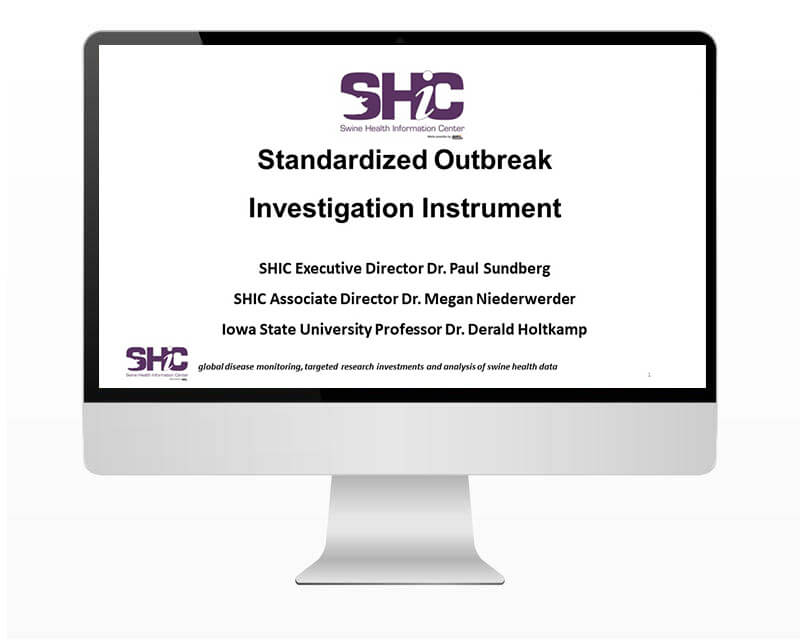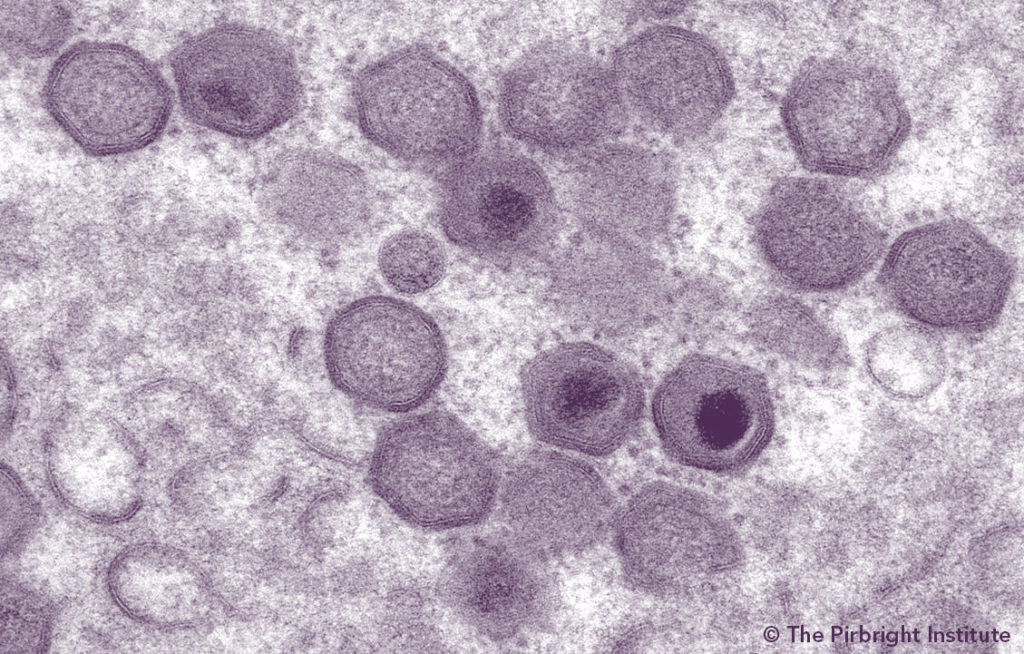
SHIC, launched by the National Pork Board in 2015 solely with Pork Checkoff funding, continues to focus efforts on prevention, preparedness, and response to novel and emerging swine disease for the benefit of US swine health. As a conduit of information and research, SHIC encourages sharing of its publications and research. Forward, reprint, and quote SHIC material freely. SHIC is funded by America’s pork producers to fulfill its mission to protect and enhance the health of the US swine herd. For more information, visit http://www.swinehealth.org or contact Dr. Sundberg at [email protected].

Ten research projects have been funded as part of the Swine Health Information Center’s Wean-to-Harvest Biosecurity Program in collaboration with the Foundation for Food & Agriculture Research and the Pork Checkoff. Each project is designed to achieve the objectives of cost-effective, innovative solutions for a significant biosecurity gap in US swine production. Institutions receiving awards in this first round of funding are Iowa State University, Carthage Veterinary Service, North Carolina State University, the University of Minnesota, and Swine Vet Center. Real-time results of round one projects will be shared as quickly as they become available, and another planned proposal solicitation round will be coming soon to seek further projects addressing the research priorities identified by industry task forces.
The Wean-to-Harvest Biosecurity Program reflects SHIC’s responsiveness to an identified health vulnerability and collaborative effort to stretch SHIC’s producer Checkoff funds to safeguard the health of the US swine herd. Proactively enhancing wean-to-harvest biosecurity will help control the next emerging disease in the US pork industry, part of SHIC’s mission.
Titles of round one Wean-to-Harvest Biosecurity Program projects awarded include:
Transportation Biosecurity
Site Biosecurity
SHIC, FFAR, and Pork Checkoff launched the two-year Wean-to-Harvest Biosecurity Program in the fall of 2022. The first call for research proposals was announced in October 2022 with the goal of investigating cost-effective, innovative technologies, protocols, or ideas to enhance biosecurity during the wean-to-harvest phases of swine production. Round one projects are expected to start March 2023.
Funding for the Wean-to-Harvest Biosecurity Program comes from SHIC, as well as FFAR and Pork Checkoff. A pool of approximately $2.3 million is available for the program, with approximately $1 million being awarded to the first round of projects.
A second call for research proposals will be announced soon with the goal of addressing a targeted set of research priorities, all with the mission of improving an identified vulnerability to swine health. Information on the second call for proposals will be shared by SHIC and posted on its website.
Swine Health Information Center
SHIC, launched by the National Pork Board in 2015 solely with Pork Checkoff funding, continues to focus efforts on prevention, preparedness, and response to novel and emerging swine disease for the benefit of US swine health. As a conduit of information and research, SHIC encourages sharing of its publications and research. Forward, reprint, and quote SHIC material freely. SHIC is funded by America’s pork producers to fulfill its mission to protect and enhance the health of the US swine herd. For more information, visit http://www.swinehealth.org or contact Dr. Paul Sundberg at [email protected].
Foundation for Food & Agriculture Research
The Foundation for Food & Agriculture Research (FFAR) builds public-private partnerships to fund bold research addressing big food and agriculture challenges. FFAR was established in the 2014 Farm Bill to increase public agriculture research investments, fill knowledge gaps and complement USDA’s research agenda. FFAR’s model matches federal funding from Congress with private funding, delivering a powerful return on taxpayer investment. Through collaboration and partnerships, FFAR advances actionable science benefiting farmers, consumers and the environment.

A standardized outbreak investigation instrument has been developed in response to an industry need for a consistent tool for these efforts. Development of the instrument has been led by Dr. Derald Holtkamp, Iowa State University, and collaborators. Prompted and funded by the Swine Health Information Center, the new instrument is available for download and use from the SHIC website and a web-based version will be launched this spring.
Click here to access a conversation about the new instrument between Dr. Holtkamp and SHIC Executive Director Dr. Paul Sundberg and SHIC Associate Director Dr. Megan Niederwerder.
Dr. Holtkamp engaged a working group of 12 academics and swine veterinarians to assist in development of the standardized outbreak investigation instrument. The goal is to use the outbreak investigation instrument to improve biosecurity for endemic diseases and be better prepared to respond to the introduction of transboundary diseases.
The new instrument is available now on the SHIC website for producers and veterinarians to download and use. The downloadable version is a fillable form that upon completion could be submitted to a program administrator at ISU. Or it could be used for farm/system outbreak investigations without submitting. But every submission will strengthen the confidential, without identifiers, database that can be mined to find industry trends and opportunities to learn from the collective experience and strengthen industry-wide biosecurity. When the web-based version is available in the coming weeks, veterinarians will contact the ISU-based administrator for access, a one-time process. SHIC will provide the administrator’s contact information once the web-based version is released.
“I feel really good about the instrument and approach,” Dr. Holtkamp remarked. “The reason for doing this remains trying to be better prepared to respond to the introduction of transboundary disease. However, the idea is, it’s not good enough just to have the instrument available. We need veterinarians and producers using it, getting practice with it, knowing how it works. Opportunity for this is with endemic diseases like PRRS, PEDV, Senecavirus A, diseases we already have.”
The new, standardized outbreak investigation instrument was built from, and expanded on, an existing investigation tool. Expert input and conversation led to changing some terms and creating additions. “We made a lot of incremental changes that really improved it a great deal,” Dr. Holtkamp explained.
Historically, Dr. Holtkamp says producers ask veterinarians to conduct outbreak investigations. However, students are not always taught how to do this in veterinary school. “Outbreaks are crises. Usually, in the aftermath of crises is when people are most interested in finding out what went wrong and asking, how can I prevent this in the future,” Dr. Holtkamp stated.
While motivation to determine the cause of outbreaks has existed, a standardized instrument for the process was not available. “Here’s an instrument you can use that has a lot of investment in time and expertise to do investigations a lot better,” Dr. Holtkamp commented. “Producers want veterinarians to use the best available tools.”
Investigations are designed to learn where producers should devote time and effort, where to prioritize the most significant biosecurity hazards on the farm. The only way to identify where those biosecurity hazards are is to be deliberate about the investigation and this instrument will help.
A completed investigation instrument results in two reports. The full report captures everything that was learned during the investigation to highlight the most significant hazards and second, a summary report helps producers prioritize where they would like to invest their resources in biosecurity control measures.
Dr. Holtkamp believes the saying we learn from our mistakes isn’t always accurate. “There’s no guarantee just because we make mistakes, we’re going to learn from them,” he concluded. “With this new instrument, we can learn faster from outbreaks that are fundamentally mistakes.”
Dr. Holtkamp leads the SHIC Rapid Response Program and says going forward there are plans to get members of Rapid Response Teams trained with the standardized outbreak investigation instrument. They would then be able to set up and conduct investigations using the web-based outbreak investigation instrument.

As PRRSV strains continue to affect pork production in the US and around the world, SHIC and AASV held a webinar on February 21, 2023, to provide the latest information on challenges caused by emerging strains of this virus. Webinar presenters addressed the PRRSV L1C variant of RFLP 1-4-4 and PRRSV L1C 1-2-4 affecting the US swine population, and Rosalia, a PRRSV-1 strain with increased virulence affecting swine production in Spain. SHIC’s mission includes sharing global disease risk and perspectives like these surrounding PRRSV in the effort to safeguard US swine herd health.
The webinar featured presenters Dr. Enric Mateu, Autonomous University of Barcelona (Spain), Drs. Daniel Linhares and Giovani Trevisan, Iowa State University, Dr. Paul Yeske, Swine Vet Center (St. Peter, Minnesota), and Dr. Clayton Johnson, Carthage (Illinois) Veterinary Service. Over 300 individuals registered for the webinar with 167 participants watching live from 18 countries and 20 US states. Attendees learned about Rosalia’s significant impact on swine production in Spain, how veterinary diagnostic laboratory data reveals PRRSV movement and predicts spread, as well as on-farm experience with prevention and controls measures for PRRSV L1C variant in the US.
Dr. Mateu said 18 million pigs in Spain were impacted by Rosalia. For perspective, there are 34 million pigs total in Spain and 146 million in the EU. The primary area impacted spans 31,000 square miles in the northeast quadrant of the country. In the area of greatest prevalence, 1,000 sow farms, averaging 1,400 sows each, are present. Further, 490 farms with nursery operations exist in that area of viral circulation and 8,000 farms where pigs are finished. On sow farms, the PRRS vaccination rate is 70%, less than 20% of nursery farms are vaccinated, and less than 5% of finishing farms.
Spanish pork producers affected by Rosalia experienced abortion storms in sow herds, sow mortality, stillbirths, high mortality in suckling piglets and weaners, fewer health issues in finishing pigs, but decreased feed conversion rates. Dr. Mateu said these realities resulted in a high economic impact. On average, the most affected farms lost 15% to 20% of their annual income.
The presentation included statistics on Rosalia consequences as it has affected production in waves. Dr. Mateu said Spain is probably in a phase with decreasing impacts though the industry remains vigilant in its efforts to combat Rosalia’s impact. Vaccination, McRebelTM (management changes to reduce exposure to bacteria to eliminate losses from PRRS), changing farrowing schedules, and depopulation have all been implemented with varying results.
Drs. Daniel Linhares and Giovani Trevisan shared information about PRRSV monitoring on the Swine Disease Reporting System, a SHIC-funded collaborative project among 5 veterinary diagnostic laboratories. SDRS shares information on the activity of endemic and emerging pathogens affecting the US swine population, assisting veterinarians and producers in making informed decisions on disease prevention, detection, and management.
Using data collected from the five veterinary diagnostic labs participating in SDRS, Drs. Linhares and Trevisan shared information on PRRSV evolution and genetic variability across states. Data included information on PRRSV L1C RFLP 1-2-4. From 2009 to 2021, per SDRS, there were 421 detections of this strain then in 2022, there were 264 classifications. Their data shows PRRSV L1C variant is still an eminent animal health and production threat and is moving east, threatening 1.5 million or more sows in 2023. They reminded webinar participants of the importance of biocontainment and biosecurity in eastern states to prevent introduction of that strain into pig populations at risk in that region.
SDRS monthly reports can be accessed on the SHIC website.
Minnesota-based practitioner, Dr. Paul Yeske, shared information on what to consider during a PRRS outbreak and herd closure, also addressing depopulation/repopulation strategies. When moving through the early days of a PRRS break, Dr. Yeske said abortions and farrowing sows with retained pigs are the most common cause of sow mortality. Assisting sows in this process, just as assisting with farrowing, is essential.
His advice also included increasing breeding targets as much as possible, breeding back sows that aborted, and identifying open sows as soon as possible. To save pigs, Dr. Yeske recommended moving piglets as needed and treating them more aggressively.
Regarding herd stabilization, Dr. Yeske walked through three scenarios: allow herd to remain positive, eliminate the field strain, and depopulation/repopulation. He shared processes, recommendations, and results as well as timelines. The overview addressed McRebel-like procedures and Dr. Yeske’s cautions regarding its implementation, diagnostic monitoring, and an early weaning strategy. Depopulation/repopulation as a tool to address PRRS breaks serves as a viable strategy in the US production model, per Dr. Yeske, due to multi-site production.
When talking about biosecurity, Dr. Yeske emphasized the need for bio-containment, or how to keep the virus on the site, as equally essential to bio-exclusion, keeping the virus out. He said bio-containment is the forgotten part of biosecurity, a process addressing showering out of barns and handling mortalities as well as disposal of boots and coveralls among other practices.
Dr. Clayton Johnson shared experience with PRRSV breaks on three sow farms, each varying in intensity along with remarks on what’s working to combat PRRS. Biosecurity, understanding PRRSV strain lineage, and PRRS vaccination all have been effective tools for PRRS management. However, herd closure, prevention of latent PRRS clinical resurgence, regional PRRS management programs, and grow/finish biosecurity are all opportunities that need attention. Dr. Johnson said questions surrounding the origin of PRRSV strains lead to confusion as does knowing where the emerging strain will display virulence, and how isolate specific PRRS management strategies should be.
A discussion on tools needed for PRRSV break management was part of Dr. Johnson’s presentation as well as identification of research needs. He suggested the industry may need a working group with a focus on the latest novel PRRS strain. Another research need is barn-level examination on piglet vaccination, piglet antibiotic administration at weaning, pre-farrow vaccination of sows, and the impact of McRebel.
Complete presentations, as well as attendee questions for speakers, are all included in the full webinar available on the SHIC website.

Following detection of African swine fever in the Caribbean in 2021, USDA Animal and Plant Health Inspection Service further increased efforts to protect US swine from the transboundary disease. Two outreach campaigns designed to increase awareness were launched. The Swine Health Information Center appreciates their work to target international travelers as well as pork producers, veterinarians, and pig owners. The following overview of activities was provided by APHIS.
In 2022, as part of their international traveler campaign, APHIS placed signs in 10 international airports (Los Angeles (LAX), New York (JFK), Chicago O’Hare, Atlanta, Miami, San Francisco, Newark, Houston, San Juan (Puerto Rico), and Des Moines). Signs encouraged travelers not to bring prohibited pork products into the US. In an announcement, USDA said, “APHIS identified these airports through a pathway risk analysis that showed they present the highest risk of passengers transporting potentially infected, prohibited products.”
In addition to signage, the campaign uses digital and social media advertising focused on the top 25 international airports by travel volume. People searching for terms associated with international travel were also targeted by the campaign. Analysis shows APHIS’ campaign has produced over 63.5 million digital impressions and resulted in nearly 150,000 visits to their web page. At the time of this report, airport signs had reached over 150 million people based on airport volume.
The second campaign, APHIS’ Protect Our Pigs awareness campaign, was designed to support commercial pork producers, veterinarians, and pig owners, by providing information and resources to help safeguard the US pork industry. APHIS recognizes these stakeholders as the first line of defense against ASF domestically.
The campaign included debut of aphis.usda.gov/ProtectOurPigs, a website to house key ASF materials. Content includes downloadable fact sheets and posters, instructional videos, shareable social media graphics, and an interactive biosecurity guide. “By working together and becoming educated, APHIS, producers, veterinarians, and owners will be ready to respond immediately should an ASF outbreak be detected,” APHIS wrote.
In 2022, APHIS hosted a second ASF Action Week, an annual event incorporating webinars, reminders, and resources along with opportunities to answer and discuss questions about ASF and effective preparedness and response. APHIS reports it is planning to host its third ASF Action Week in 2023 and encourages interested parties to sign up for email alerts for the latest information on Action Week and other related activities.

In October 2022, the Swine Health Information Center joined with the Center for the Ecology of Infectious Diseases, University of Georgia to host a symposium entitled Japanese Encephalitis Virus: Emerging Global Threat to Humans & Livestock. One of the initiatives that came from the symposium was an agreement between SHIC and CEID for the latter to build and launch a JEV Information Sharing Network website. The objective is to have a JEV information resource that can answer the pork industry’s immediate questions and needs if JEV is introduced into the US. SHIC will announce the launch of the website when complete, expected within a few weeks.
This information-sharing website will be a CEID-maintained repository of pertinent JEV information available to anyone interested in JEV infectious disease dynamics. This document explains the summary for the website, examples of content, and next steps. Topic areas proposed for the website include information on JEV ecology, epidemiology, economic impacts, outbreak response plans, data, and technical literature.
JEV preparedness activities in the US include assessing the risk of JEV entry and establishment, research priorities supporting identification, surveillance, and response, and facilitating further information sharing through this ongoing CEID project. These efforts began after learning lessons from the Australian experience with JEV impacting pigs and people beginning in March of 2022.
In addition to the symposium conducted with CEID, SHIC has funded an updated, comprehensive entry and establishment risk assessment. Also, a complete literature review is being done to ensure the latest information on JEV genotype IV, the genotype causing the Australian outbreak, is available to help develop surveillance strategies, diagnostic assays, and research.
A JEV research priority list based on identified knowledge gaps, including discussions during the symposium, has been drafted. Australian retrospective testing shows JEV was circulating in the country’s swine herds for up to a year before the clinical outbreak. The wide range of impact on Australian farms – from mild to severe clinical outcomes and short to prolonged clinical disease – means work needs to be done to understand JEV’s epidemiology and how on-farm and/or regional factors influence disease transmission and progression.
Additional areas identified for investigation or confirmation include oral fluids and barn effluent surveillance, and confirming PCR testing would detect all JEV genotypes, including the genotype IV responsible for the recent Australian outbreak. Further understanding pork industry economic impacts of a US JEV incursion , as well as identifying competent avian and vector hosts for JEV, will be important. Since JEV is a mosquito disease, investigating effective mosquito control measures on swine farms is also included. As part of this process, SHIC remains in communication with Australian and US veterinarians and researchers to discuss opportunities for JEV collaboration.

This month’s Domestic Swine Disease Monitoring Report brings information about the activity of the PRRSV Lineage 1C variant of RFLP 1-4-4 in US eastern states such as Indiana, Tennessee, Ohio, and Pennsylvania. For enteric coronaviruses, PEDV and PDCoV positivity was within expected ranges in February and TGEV has no RT-PCR detection in the SDRS database for almost two years. Regarding Mycoplasma hyopneumoniae, there was an increase in submissions, but with no increase in positivity. PCV2 had an increased positivity in the wean-to-market category. Also, PDCoV, PCV2, and Clostridiosis had spikes in the number of confirmed tissue diagnosis cases during February 2023. In the SDRS podcast, hosts talk with Dr. Rebecca Robbins about the dissemination of the PRRSV L1C variant in US eastern states, enteric coronavirus elimination, and usage of SDRS data for animal health decisions.

The first outbreak of African swine fever has been reported in Singapore. Learn more about this 17th nation in Asia to be affected by ASF since its first incursion in China in 2018 in this month’s Global Swine Disease Monitoring Report. In addition, the eighth ASF case in domestic pigs was found in Brandenburg, Germany. A concerning increase in Nipah virus infections since mid-January in Bangladesh is reported. With 10 cases confirmed already, it makes it the largest outbreak since 2015. Click here for SHIC’s Nipah virus fact sheet.
Copyright 2024 | Swinehealth.org | Website by Heartland Marketing Group